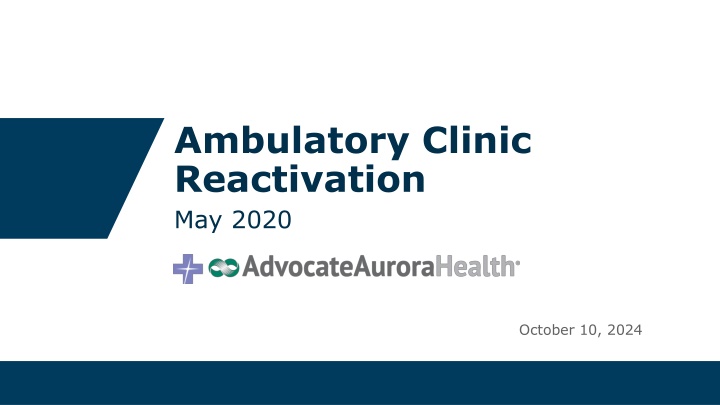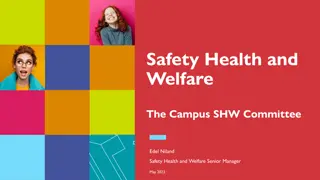Advocate Aurora Safe Care Strategy - Health and Safety Measures
The Advocate Aurora Safe Care Strategy prioritizes health and safety by implementing measures such as screening, masking, social distancing, virtual check-ins, and enhanced cleaning. The framework for reactivation outlines gradual reintroduction of care with a focus on patient risk management. Alternative locations are utilized for ineligible patients, ensuring a safe environment for all.
Uploaded on Oct 10, 2024 | 3 Views
Download Presentation

Please find below an Image/Link to download the presentation.
The content on the website is provided AS IS for your information and personal use only. It may not be sold, licensed, or shared on other websites without obtaining consent from the author.If you encounter any issues during the download, it is possible that the publisher has removed the file from their server.
You are allowed to download the files provided on this website for personal or commercial use, subject to the condition that they are used lawfully. All files are the property of their respective owners.
The content on the website is provided AS IS for your information and personal use only. It may not be sold, licensed, or shared on other websites without obtaining consent from the author.
E N D
Presentation Transcript
Ambulatory Clinic Reactivation May 2020 October 10, 2024
Advocate Aurora Safe Care Strategy We re Here For You Your health and safety is our highest priority. The Advocate Aurora Safe Care Promise provides additional measures to protect you and our team members. In person or online, we are here for you. Focus Our Promise to Consumers, Patients & Team Members Patients, team members, providers and approved guests are all screened prior to entering all sites of care Screening Patients, team members, providers and approved guests are all provided with a mask prior to entering all sites of care Masking Social Distancing Our newly designed waiting areas and staggered appointment times reduce traffic, minimizing contact and creating safe spaces for all Virtual Check-In Virtual check-in through the LiveWell app, provides for seamless, low-contact arrivals Enhanced Cleaning All public and treatment areas will undergo additional disinfectant and cleaning throughout the day and hand sanitizer will be readily available throughout our campuses 2
Framework for Reactivation Goal: Provide a framework to close care gaps with patients as well as reintroduce gradual volume for ambulatory patients, clinicians, and team members. Using a progressive introduction of increased ability with effective patient risk management, ensuring a safe environment for our patients, clinicians, and team members. Phases 4 & 5 LiftRestrictions Ability to perform in-personcare under appropriateguidelines Phase1 Phases 2 & 3 Re-OpenServices ReduceTransmission Consider postponing in-person care, use virtual platformbasedon patient factors Postpone in-person, use virtual platform for care until shiftto appropriatephase Ability to perform in-personcareat modified COVID UC/IMC, or use virtual platform asymptomatic High RiskPatient High Risk Patient High RiskPatient Low RiskPatient Low RiskPatient Low RiskPatient symptomatic High Risk Patient High Risk Patient High Risk Patient High-Risk Patient: 65 years+, living in a nursing home/ LTAC, underlying medical conditions, chronic lung, heart, liver, diabetes, or kidney disease; asthma; immunocompromised (cancer, smoking, etc.), severe obesity 40+ BMI, etc. Low RiskPatient Low RiskPatient Low RiskPatient Appropriate care venueis recommended at the site / clinician level 3
Framework for Reactivation Alternative Locations for Ineligible Patients Trigger Acceptable Ambulatory Clinic Patients Acute visits for patients who have screened negative for COVID symptoms, including those in a high-risk category Successful implementation of modified schedule throughout clinic Current State Patients who are COVID asymptomatic & high-risk are strongly encouraged to be seen via video visit. One For specialty practice, consult with physician regarding need to have patient seen in-person. Consider video visit. If the patient needs to be seen in-person, then schedule and prepare with plan for appropriate PPE, PPE conservation, distancing from asymptomatic and high risk patients. Non-Acute & Acute visits for patients who have screened negative for COVID symptoms, including those in a high-risk category Schedule modification: Three in-person patients/hour or 50% of Epic schedule template (whichever is less) Validation of policies/procedures in place as defined Site Safety measures achieved and PPE demand aligned Two Non-Acute & Acute visits for patients who have screened negative for COVID symptoms, including those in a high-risk category Add patients who are not in a high-risk category that meet criteria based on COVID+ Patients in Ambulatory/Outpatient setting practice guidance** Schedule modification: Up to five in-person patients/hour or 75% of Epic schedule template (whichever is less) Non-Acute and Acute visits for patients who have screened negative for COVID symptoms, including those in a high-risk category All patients that meet criteria based on COVID+ Patients in Ambulatory/Outpatient setting practice guidance ** Schedule modification: In-person patients / hour can return to match pre-COVID volumes/scheduling templates Validation of consistency and ability to expand within policies/procedures for additional volume up to at least 60% of site based pre-COVID visit volume (includes video visits) for one week* Site Safety measures maintained and PPE aligned PHASE Patients who are COVID symptomatic and are in need of an urgent evaluation are directed to a modified UC/ ICC. Three Validated ability to expand up to at least 75% of site based pre-COVID visit volume (includes video visits) for one week and maintain separate workflows for high-risk patients* Site Safety measures maintained and PPE aligned Four N/A Return to full ambulatory access Five *Special consideration to progress to next phase will be given to practices where demand or schedule limitations inhibit the % goal ** Link to COVID+ Patients Presenting for Ambulatory/Outpatient Services practice guidance 4
System Ambulatory Standards Framework is based on the overall impact and incidence of COVID in respective market or PSA. It will not be rolled out on a System-standard timeline. Ability to move between phases (either up or down) will be determined by market recommendation and approval of ambulatory governance. A clinic or a suite will need to move collectively within phases. Individual Clinician Schedules for Phases 1 3: Limiting parameters around in-person visits while workflows are established. Ability to supplement with video and telephone visits to maintain access and volumes. Once in Phase 4, clinician schedules return to pre-COVID parameters/capacity. Video Visits will continue to be the first offering to patients when scheduling provided the service requested is deemed video-eligible by physician leadership. Non-Acute visits include Wellness Checks, Referrals/Consults, Pre-op and Regular Physicals. 5
System Ambulatory Standards Framework is based on the overall impact and incidence of COVID in respective market or PSA. It will not be rolled out on a System-standard timeline. Team Members will abide by published PPE guidelines and conservation techniques to contribute to system PPE management efforts. Review PPE Resource Guide with Clinicians and Team members Review PPE Resource Guide with Clinicians and Team members All patients are universally screened over the telephone by respective clinic-specific staff the day prior to the visit and receive communication on pre-visit and arrival procedures. Universal Screening Pre-Visit Workflow Universal Screening Pre-Visit Workflow Screening of patients and chaperones will continue at our clinic front entrances for the immediate future. Universal Screening Workflow Universal Screening Workflow 6
Ambulatory Governance Market leadership will make recommendation on sites moving up or down a phase. This recommendation will be reviewed against the ambulatory checklist by the IL or WI ambulatory governance team who will approve site movement amongst phases. These teams will be responsible for: 1. Ensuring sites meet the criteria for reactivation 2. Decisions regarding progression of phases 3. Maintaining an inventory of clinics and their respective reactivation status 4. Share best practices around workflow, decision making, safety, and PPE conservation 7
Checklist link to checklist Available on the COVID-19 Information Center 8























